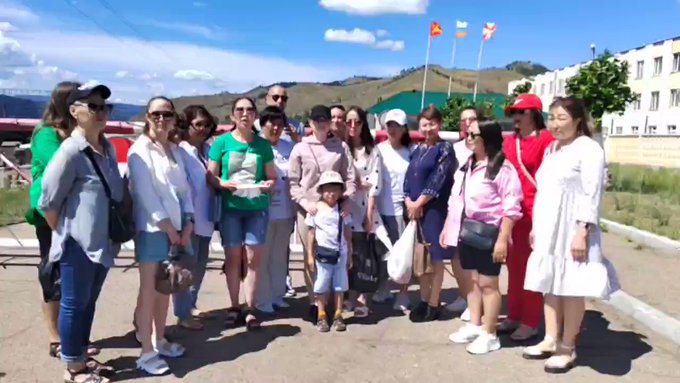
Resistance to the war is deeply crushed in Russia, but has not disappeared
A young woman in light-colored jeans and sturdy-soled boots walks with a banner under her arm to the central square of Ulan-Ude, the capital of the Siberian Republic of Buryatia. She is on her way to a protest announced on Instagram against the war in Ukraine and mobilization. But when she arrives, she only sees police officers instead of demonstrators.
Human rights activist Nadezhda Nizovkina also came to the square. For her YouTube channel she reports live from all events in her city. And when it comes to arrests, she offers legal aid to protesters — she captures everything on camera.
According to Nizovkina, this is exactly what the resistance in Buryatia looks like at the moment, she says over the phone from Ulan-Ude: “Someone goes out onto the street with a banner, and a little later someone else comes along. The police intervened immediately, arresting the demonstrators and unsuspecting passers-by at the same time. In the villages it is even more difficult. If someone there comments on social media about the mobilization, someone is immediately at the door to pick them up.”
Protest against the mobilization in the center of Ulan-Ude:

Улан-Удэ десятки человек вышли на акцию против мобилизации
Elsewhere in Russia there is little visible resistance either, while immediately after the announcement of the “partial mobilization” – now more than a month ago – countless protesters took to the streets in Russia.
The protests were particularly strong in Dagestan, Yakutia and Tuva – “national republics” with a large ethnic minority. Especially the poor regions on the fringes of Russia are disproportionately affected by war and mobilization. They also count by far the most casualties on the battlefield. Dagestan tops the list with 310 registered deaths. It is followed by Buryatia with 288 deaths (as of October 7).
Immediately after the announcement, busloads of men were also transported to the mobilization centers in remote Buryatia, on the border with Mongolia. It has already been called “the worst night in Buryat life”.
Buryat women are asking the authorities to bring their sons home from the front
The protest that first evening was smaller. Images circulated on social media of a woman holding a banner that read, “Our husbands, sons and fathers do not kill other men, fathers and sons.” Mobile units arrested at least four protesters, including Nizovkina, who also live-streamed the action on her YouTube channel. She was detained for two nights.
But after that outburst of popular anger in the early days of mobilization, all the country remained awkwardly silent. Nevertheless, according to Nizovkina, the mobilization radically changed the attitude of the population. Nizovkina: “A rapidly growing group of newcomers who have never been politically active before are opposed to the war. Before the mobilization, the letters Z and V were everywhere on cars and buildings, on T-shirts, on balconies. Citizens use them to symbolize their support for Putin and his war. Now they have suddenly disappeared and with them the warmongering.”
The resistance initially consists of a series of one-man actions, says Nizovkina. For example, the pensioner who recently took to the streets in Ulan-Ude with a banner and the text “Stand up for freedom”. Or the unidentified activists who earlier this month set fire to the Russian flag with the V sign on the statue of Lenin in the center and circulated the images of their action via telegram.
support from abroad
At the same time, the resistance in Buryatia is receiving support from a completely different quarter: from Buryat emigration, primarily in the USA, Kazakhstan and South Korea. They have joined forces in the Free Buryatia Foundation. Immediately after the announcement of the mobilization, the organization, with donations from its members, organized a dozen buses to take men from Buryatia across the border into Mongolia. It is estimated that between 3,000 and 4,000 Buryats have fled the country since September 21.
At the beginning of the war, a team of lawyers from the Free Buryatia Foundation managed to bring a group of Buryat soldiers home, director Aleksandra Garmazjapova said by phone from Astana, the capital of Kazakhstan. “They were imprisoned because they refused to fight. Since we already had legal expertise in-house, we were also able to react appropriately to the new reality of mobilization.” For example, the foundation provided legal support to mobilized people who had been unjustly summoned.
Buryats abroad have also spoken out against the war in a powerful YouTube video. “Russian state media keep talking about Putin’s ‘Buryat warriors’.” says Garmaziapova. “It also happened again and again that war crimes were erroneously attributed to Buryat soldiers, including in Butya.”
Buryats around the world speak out against the war:

отив войны! Ч.1. Buryats against the war! ад арад зон энэ дайн дэмжэнэгүй!
This creates the impression that it is not ethnic Russians who are to blame for atrocities, but barbarians from Asia. Garmazjapova wants to fight this image.
Following the example of the Free Buryatia Foundation, other ethnic groups in exile are also closely following the events in their homeland and have joined forces to succeed the Free Buryatia Foundation, such as Free Yakutia, New Tuva and Free Kalmykia.
NOS made a video in April about the many ethnic minorities who fell on the battlefield

Author: Paul Alexander
Source: NOS
I am David Miller, a highly experienced news reporter and author for 24 Instant News. I specialize in opinion pieces and have written extensively on current events, politics, social issues, and more. My writing has been featured in major publications such as The New York Times, The Guardian, and BBC News. I strive to be fair-minded while also producing thought-provoking content that encourages readers to engage with the topics I discuss.








